Science and Technology/Engineering
22 Grade 5
Lauren Weiss and Margaret Krone
Connections and Relationships in Systems
In grade 5, students model, provide evidence to support arguments, and obtain and display data about relationships and interactions among observable components of different systems. By studying systems, grade 5 students learn that objects and organisms do not exist in isolation and that animals, plants and their environments are connected to, interact with, and are influenced by each other. They study the relationships between Earth and other nearby objects in the solar system and the impact of those relationships on patterns of events as seen from Earth. They learn about the relationship among elements of Earth’s systems through the cycling of water and human practices and processes with Earth’s resources. They also learn about the connections and relationships among plants and animals, and the ecosystems within which they live, to show how matter and energy are cycled through these (building on the theme of grade 4). An ability to describe, analyze, and model connections and relationships of observable components of different systems is key to understanding the natural and designed world.[1] [2]
ESS3. Earth and Human Activity
- 5-ESS3-1. Obtain and combine information about ways communities reduce human impact on the Earth’s resources and environment by changing an agricultural, industrial, or community practice or process.
Falcon Curriculum Core Categories
Conservation and Policy
Falcon Curriculum Essential Question
How have humans changed their agricultural and industrial practices re: pesticides to conserve the environment/peregrine falcons?
Materials
| For Instructors | For Students |
|---|---|
|
|
Sample Plan
Read About Falcons: Conservation and watch the Falcon Curriculum: Conservation, Beginner videos. Talk about how humans had to change the agricultural and industrial practice of using DDT as a pesticide in order to conserve the environment/peregrine falcons.
Do the Soft Shelled Egg Experiment:

- Explain/review the Scientific Method: a process with a set of steps that scientists use to study the world around them and solve problems.
- Put students into groups. Let them examine the egg. Have them fill out a Scientific Method sheet:
- Ask a question, based on observations: Scientists observed that peregrine falcon eggs affected by DDT did not hatch. Why didn’t DDT-affected eggs hatch? (Observe what regular eggs that can hatch look and feel like.)
- Make a hypothesis (prediction): If the eggs don’t have strong eggshells to protect the chicks, then the eggs won’t hatch.
- Test the hypothesis:
- Examine the egg and record observations (shell is hard, etc.)
- Pour 1 cup vinegar into clear jar.
- Add the egg.
- Talk about what happens (bubbles will rise from the egg) and what they think might happen after it sits in the vinegar for 1 day.
- Leave the egg in the vinegar for 1 day.
- Remove the egg and and record observations (soft). IMPORTANT: if you are using a raw egg and not hardboiled, make sure the students are gentle with it when they touch it, or it will break all over.
- Analyze the data: Compare regular eggs to the ones in the vinegar. Regular eggs have hard shells sturdy enough to protect the chicks and withstand parents sitting on them to incubate them. Vinegar dissolves the calcium in the eggshells, leaving the eggs with just the soft eggshell lining.
Draw conclusions: DDT affected the calcium content peregrine falcons had, which made them lay eggs with soft shells that couldn’t protect the chicks, so they couldn’t hatch. Since the eggs couldn’t hatch, the falcon population declined. - Communicate findings: Do a brief lab report or poster sharing the data.
LS2. Ecosystems: Interactions, Energy, and Dynamics
- 5-LS2-1. Develop a model to describe the movement of matter among producers, consumers, decomposers, and the air, water, and soil in the environment to (a) show that plants produce sugars and plant materials, (b) show that animals can eat plants and/or other animals for food, and (c) show that some organisms, including fungi and bacteria, break down dead organisms and recycle some materials back to the air and soil.
Falcon Curriculum Core Categories
Anatomy and Life Cycle
Animal Behavior
Falcon Curriculum Essential Question
How are falcons part of the movement of matter?
Materials
| For Instructors | For Students |
|---|---|
|
|
Sample Plan
Have students make charts demonstrating the movement of matter and energy using peregrine falcons, their prey, what their prey eat, etc. Each student can pick a different prey and research its diet to add that to the chart.
PS3. Energy
- 5-PS3-1. Use a model to describe that the food animals digest (a) contains energy that was once energy from the Sun, and (b) provides energy and nutrients for life processes, including body repair, growth, motion, body warmth, and reproduction.
Falcon Curriculum Core Categories
Anatomy and Life Cycle
Animal Behavior
Falcon Curriculum Essential Question
How do falcons get energy and nutrients?
Materials
| For Instructors | For Students |
|---|---|
|
|
Sample Plan
Media Attributions
- Soft Shelled Egg Experiment Results
- Massachusetts Department of Elementary and Secondary Education (2022). SCIENCE AND TECHNOLOGY / ENGINEERING Grades Pre-Kindergarten to 12 Massachusetts Curriculum Framework. https://www.doe.mass.edu/frameworks/current.html ↵
- Falcon Curriculum Common Core Standards mapping by Margaret Krone. Falcon Curriculum Lesson Plans by Lauren Weiss. © 2022 CC BY 4.0 ↵

